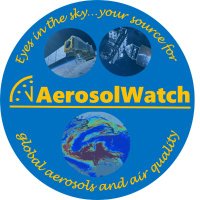
AerosolWatch
@aerosolwatch
Global aerosols & air quality information, featuring NOAA satellite products from the AerosolWatch website
ID: 1221086580774928386
https://www.star.nesdis.noaa.gov/smcd/spb/aq/AerosolWatch/ 25-01-2020 15:05:33
2,2K Tweet
3,3K Followers
252 Following

This morning 9 Jun, Aerosol Optical Depth (AOD) from ABI on NOAA Satellites GOES-East shows ongoing impacts of Canadian wildfires’ smoke: thick smoke over SE Canada & moderately thick smoke flowing into central CONUS around circulation of Low pressure centered over Lake Superior.



On 11 Jun, the latest intrusion of Canadian wildfire smoke cut a swath of Unhealthy (Code Red) to USG (Code Orange) daily PM2.5 air quality across MT, ND & MN and widespread Moderate (Code Yellow) conditions in the upper Midwest & Great Lakes regions. Joint Polar Satellite System (JPSS) NOAA Satellites


Composite gridded aerosol optical depth (AOD) from the VIIRS sensor on Joint Polar Satellite System (JPSS) NOAA Satellites SNPP & NOAA-20 for 11 Jun shows long-range transport of smoke from the Canadian wildfires (dark red shading) over the northern Atlantic Ocean, northern Europe & central Asia.


Smoke (red/dark red shading) from western Canada wildfires moved over southern Alaska yesterday 15 Jun, observed by aerosol optical depth from VIIRS on Joint Polar Satellite System (JPSS) NOAA Satellites NOAA-20. Smoke appears to be aloft b/c no impacts on surface air quality in Anchorage. Jingqiu Mao


Atmospheric carbon monoxide (CO) measured by TROPOMI on Copernicus EU Sentinel-5P reveals transport of wildfire emissions to Alaska on 16 Jun from fires burning near the borders Yukon, Northwest Territories, British Columbia & Alberta, Canada. GINA Alaska's Weather Source


This afternoon 17 Jun, ABI on NOAA Satellites GOES-East is observing wildfires burning in southern Utah & southwestern New Mexico (yellow/orange markers, Fire Radiative Power) that are producing thick smoke plumes, which are blowing southeastward.

In a narrow band along its path, smoke from the Trout Creek wildfire in New Mexico caused estimated Very Unhealthy (Code Purple), Unhealthy (Code Red) & USG (Code Orange) daily PM2.5 air quality on 17 Jun, per VIIRS on Joint Polar Satellite System (JPSS) satellites. NOAA Satellites


Fire season in Alaska has begun. Aerosol optical depth (AOD) from VIIRS on Joint Polar Satellite System (JPSS) NOAA-20 observed thick smoke (dark red shading) over eastern Alaska yesterday 22 Jun, which caused Unhealthy (Code Red) daily PM2.5 air quality in Fairbanks. NOAA Satellites NWS Fairbanks


Devastating wildfires on the eastern Greek island of Chios emitted thick smoke that blew southwestward on 23 Jun, observed by Joint Polar Satellite System (JPSS) VIIRS aerosol optical depth (AOD >0.5). Also evident is a smaller plume from a wildfire near Papadianika in southern Greece. NOAA Satellites


Thick smoke (dark red shading) from ongoing seasonal wildfires in Siberia Russia covered a large area near the borders with China & Mongolia today 26 Jun, observed by Joint Polar Satellite System (JPSS) VIIRS aerosol optical depth from the NOAA-21 satellite. NOAA Satellites


The ABI sensor on NOAA Satellites GOES-East observed several large plumes of Saharan dust (yellow shading) moving westward over the tropical Atlantic Ocean, between the West Africa coast & the Caribbean, this afternoon 27 Jun. Dust Storm News


Fire radiative power from the VIIRS sensor on Joint Polar Satellite System (JPSS) NOAA-21 observed an intensely burning wildfire (orange markers) in western Turkey yesterday 29 Jun, which emitted a thick, brown-colored smoke plume that blew offshore. NOAA Satellites


Smoke from the ongoing wildfires in western & central Canada is moving into MN & IA this morning 1 Jul, as observed by the ABI sensor on NOAA Satellites GOES-East. During the 1300-1359 UTC hour, the smoke pushed PM2.5 concentrations to the 20-30 ug/m3 range in northern MN. Minnesota Pollution Control Agency

To our data users: Due to an issue with our center’s data repository this morning 2 Jul, near real-time imagery from ABI on the GOES-East and GOES-West satellites is very delayed on the AerosolWatch website star.nesdis.noaa.gov/smcd/spb/aq/Ae…. Our colleagues are working to resolve the issue.

The ABI sensor on NOAA Satellites GOES-West captured the start of the very fast-growing Madre Fire in San Luis Obispo County, CA yesterday afternoon 2 Jul. Shown here is the Aerosol Detection Product (ADP, lavender shading) that helps highlight smoke. San Luis Obispo County Fire Department NOAA Communications

The Madre Fire in San Luis Obispo County continued to burn over the holiday weekend. It is 30% contained per CAL FIRE. The VIIRS sensor on Joint Polar Satellite System (JPSS) NOAA-21 shows the fire locations & intensity (Fire Radiative Power) and extent of smoke on 4 Jul. NOAA Satellites Bureau of Land Management California

